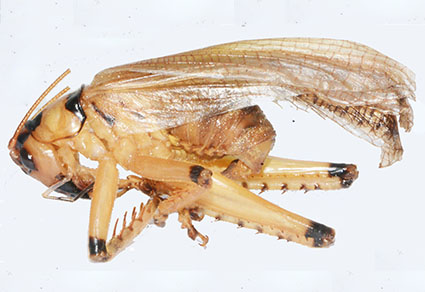Abstract
The genus Ultragryllacris is mainly distributed in China and Thailand, and the type species Ultragryllacris pulchra Gorochov & Dawwrueng, 2015 includes four subspecies. Up to now, these subspecies were identified mainly based on their morphological characteristics, and no study on the molecular identification of subspecies and phylogenetic analyses has been reported. Here we obtained three mitogenomes of U. pulchra rubricapitis and one mitogenome of Homogryllacris yunnana and reconstructed the relationship of Ultragryllacris among genera. Species identification was performed with ABGD, jMOTU, and NJ tree based on cox1 (658 bp) and cob (550 bp) genes. The mitogenomes of U. pulchra rubricapitis and H. yunnana were 15558–16625 bp and 16209 bp in length, respectively. Most of the PCGs started with the typical ATN codons and terminated with complete TAA/TAG. Four mitogenomes showed positive AT skews and negative GC skews. Besides, the phylogenetic tree of BI and ML revealed that Ultragryllacris was a monophyletic group. One geographical population of Ultragryllacris pulchra rubricapitis was described and illustrated.
References
Bernt, M., Donath, A., Jühling, F., Externbrink, F., Florentz, C., Fritzsch, G., Pütz, J., Middendorf, M. & Stadler, P.F. (2013)
MITOS: improved de novo metazoan mitochondrial genome annotation. Molecular Phylogenetics and Evolution, 69 (2), 313–319. https://doi.org/10.1016/j.ympev.2012.08.023
Bin, W. & Bian, X. (2021) One new subspecies of the genus Ultragryllacris Gorochov & Dawwrueng, 2015 (Orthoptera: Gryllacrididae: Gryllacridinae) and its new record from China. Zootaxa, 5047 (5), 596–600. https://doi.org/10.11646/zootaxa.5047.5.10
Cigliano, M.M., Braun, H., Eades, D.C. & Otte, D. (2022) Orthoptera Species File. Version 5.0/5.0. [DB/OL]. Available from: http:// Orthoptera.SpeciesFile.org (accessed October 8, 2022)
Dierckxsens, N., Mardulyn, P. & Smits, G. (2017) NOVOPlasty: de novo assembly of organelle genomes from whole genome data. Nucleic Acids Research, 45 (4), e18. https://doi.org/10.1093/nar/gkw955
Gorochov, A.V., Dawwrueng, P. & Artchawakom, T. (2015) Study of Gryllacridinae (Orthoptera: Stenopelmatidae) from Thailand and adjacent countries: the genera Ultragryllacris gen. nov. and Capnogryllacris. Zootaxa, 4021 (4), 565–577. https://doi.org/10.31610/zsr/2015.24.2.219
Kumar, S., Stecher, G. & Tamura, K. (2016) MEGA7: Molecular Evolutionary Genetics Analysis version 7.0 for Bigger Datasets. Molecular Biology and Evolution, 33 (3), 1870–1874. https://doi.org/10.1093/molbev/msw054
Liu, J., Lu, X.Y., Zhang, Q.W., Wu, X.Y., Yang, D.D. & Bian, X. (2022) Contribution to the knowledge of Chinese Gryllacrididae (Orthoptera) V: Further study on the Chinese Capnogryllacris and comment on the phylogenetic relationships of the Gryllacrididae. Zootaxa, 5099 (1), 001–045. https://doi.org/10.11646/zootaxa.5099.1.1
Liu, J., Lu, X.Y. & Bian, X. (2021a) One new species of Homogryllacris Liu, 2007 from China with comments on the characters of mitochondrial genome (Orthoptera: Gryllacrididae; Gryllacridini). Zootaxa, 4985 (4), 451–458. https://doi.org/10.11646/zootaxa.4985.4.1
Liu, J., Wu, X.Y. & Bian, X. (2022b) Contribution to the knowledge of Chinese Gryllacrididae (Orthoptera) IV: New additions of Chinese Furcilarnaca Gorochov, 2004. Zootaxa, 5087 (2), 335–356. https://doi.org/10.11646/zootaxa.5087.2.5
Liu, J., Yang, H.Q., Lu, X.Y. & Bian, X. (2021) New species of Eugryllacris (Orthoptera: Gryllacrididae) from Yunnan, China. Zootaxa, 5026 (4), 586–594. https://doi.org/10.11646/zootaxa.5026.4.8
Song, H.J, Amédégnato, C., Cigliano, M.M., Desutter-Grandcolas, L., Heads, S.W., Huang, Y., Otte, D., Whiting, M.F. (2015) 300 million years of diversification: elucidating the patterns of orthopteran evolution based on comprehensive taxon and gene sampling. Cladistics, 31 (6), 621–651. https://doi.org/10.1111/cla.12116
Yuan, H., Huang, Y., Mao, Y., Zhang, N., Nie, Y.M., Zhang, X., Zhou, Y.F. & Mao, S.L. (2021) The Evolutionary Patterns of Genome Size in Ensifera (Insecta: Orthoptera). Frontier in Genetics, 12, 693541. https://doi.org/10.3389/fgene.2021.693541
Zhang, D., Gao, F., Jakovli´c, I., Zou, H., Zhang, J., Li, W. & Wang, G. (2020) PhyloSuite: An integrated and scalable desktop platformfor streamlined molecular sequence data management and evolutionary phylogenetics studies. Molecular Ecology Resources, 20 (1), 348–355. https://doi.org/10.1111/1755-0998.13096
Zhou, Z.J., Zhao, L., Liu, N., Guo, H.F., Guan, B., Di, J.X. & Shi, F.M. (2017) Towards a higher-level Ensifera phylogeny inferred from mitogenome sequences. Molecular Phylogenetics and Evolution, 108, 22–33. https://doi.org/10.1016/j.ympev.2017.01.014


